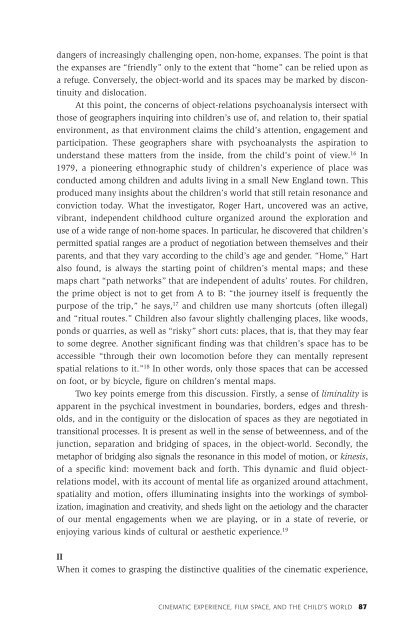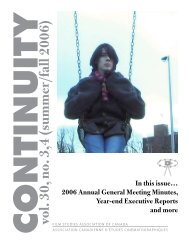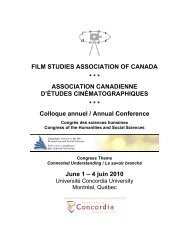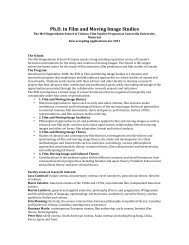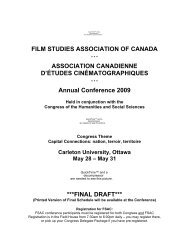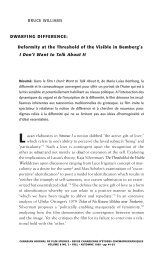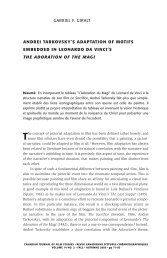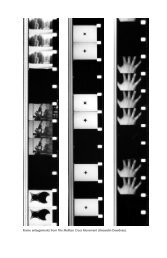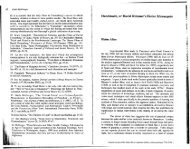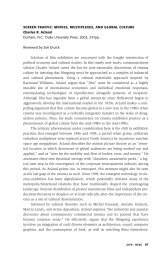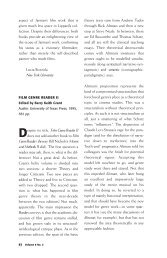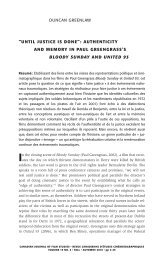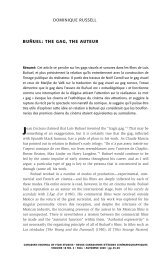cinematic experience, film space, and the child's world - Film Studies
cinematic experience, film space, and the child's world - Film Studies
cinematic experience, film space, and the child's world - Film Studies
Create successful ePaper yourself
Turn your PDF publications into a flip-book with our unique Google optimized e-Paper software.
005.Kuhn.19.2:005.Kuhn. 11/18/10 5:32 PM Page 87<br />
dangers of increasingly challenging open, non-home, expanses. The point is that<br />
<strong>the</strong> expanses are “friendly” only to <strong>the</strong> extent that “home” can be relied upon as<br />
a refuge. Conversely, <strong>the</strong> object-<strong>world</strong> <strong>and</strong> its <strong>space</strong>s may be marked by discontinuity<br />
<strong>and</strong> dislocation.<br />
At this point, <strong>the</strong> concerns of object-relations psychoanalysis intersect with<br />
those of geographers inquiring into children’s use of, <strong>and</strong> relation to, <strong>the</strong>ir spatial<br />
environment, as that environment claims <strong>the</strong> child’s attention, engagement <strong>and</strong><br />
participation. These geographers share with psychoanalysts <strong>the</strong> aspiration to<br />
underst<strong>and</strong> <strong>the</strong>se matters from <strong>the</strong> inside, from <strong>the</strong> child’s point of view. 16 In<br />
1979, a pioneering ethnographic study of children’s <strong>experience</strong> of place was<br />
conducted among children <strong>and</strong> adults living in a small New Engl<strong>and</strong> town. This<br />
produced many insights about <strong>the</strong> children’s <strong>world</strong> that still retain resonance <strong>and</strong><br />
conviction today. What <strong>the</strong> investigator, Roger Hart, uncovered was an active,<br />
vibrant, independent childhood culture organized around <strong>the</strong> exploration <strong>and</strong><br />
use of a wide range of non-home <strong>space</strong>s. In particular, he discovered that children’s<br />
permitted spatial ranges are a product of negotiation between <strong>the</strong>mselves <strong>and</strong> <strong>the</strong>ir<br />
parents, <strong>and</strong> that <strong>the</strong>y vary according to <strong>the</strong> child’s age <strong>and</strong> gender. “Home,” Hart<br />
also found, is always <strong>the</strong> starting point of children’s mental maps; <strong>and</strong> <strong>the</strong>se<br />
maps chart “path networks” that are independent of adults’ routes. For children,<br />
<strong>the</strong> prime object is not to get from A to B: “<strong>the</strong> journey itself is frequently <strong>the</strong><br />
purpose of <strong>the</strong> trip,” he says, 17 <strong>and</strong> children use many shortcuts (often illegal)<br />
<strong>and</strong> “ritual routes.” Children also favour slightly challenging places, like woods,<br />
ponds or quarries, as well as “risky” short cuts: places, that is, that <strong>the</strong>y may fear<br />
to some degree. Ano<strong>the</strong>r significant finding was that children’s <strong>space</strong> has to be<br />
accessible “through <strong>the</strong>ir own locomotion before <strong>the</strong>y can mentally represent<br />
spatial relations to it.” 18 In o<strong>the</strong>r words, only those <strong>space</strong>s that can be accessed<br />
on foot, or by bicycle, figure on children’s mental maps.<br />
Two key points emerge from this discussion. Firstly, a sense of liminality is<br />
apparent in <strong>the</strong> psychical investment in boundaries, borders, edges <strong>and</strong> thresholds,<br />
<strong>and</strong> in <strong>the</strong> contiguity or <strong>the</strong> dislocation of <strong>space</strong>s as <strong>the</strong>y are negotiated in<br />
transitional processes. It is present as well in <strong>the</strong> sense of betweenness, <strong>and</strong> of <strong>the</strong><br />
junction, separation <strong>and</strong> bridging of <strong>space</strong>s, in <strong>the</strong> object-<strong>world</strong>. Secondly, <strong>the</strong><br />
metaphor of bridging also signals <strong>the</strong> resonance in this model of motion, or kinesis,<br />
of a specific kind: movement back <strong>and</strong> forth. This dynamic <strong>and</strong> fluid objectrelations<br />
model, with its account of mental life as organized around attachment,<br />
spatiality <strong>and</strong> motion, offers illuminating insights into <strong>the</strong> workings of symbolization,<br />
imagination <strong>and</strong> creativity, <strong>and</strong> sheds light on <strong>the</strong> aetiology <strong>and</strong> <strong>the</strong> character<br />
of our mental engagements when we are playing, or in a state of reverie, or<br />
enjoying various kinds of cultural or aes<strong>the</strong>tic <strong>experience</strong>. 19<br />
II<br />
When it comes to grasping <strong>the</strong> distinctive qualities of <strong>the</strong> <strong>cinematic</strong> <strong>experience</strong>,<br />
CINEMATIC EXPERIENCE, FILM SPACE, AND THE CHILD’S WORLD 87


